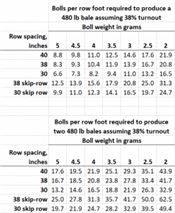|
Estimating Lint Yield From Boll Counts
DR. TYSON RAPER
JACKSON, TENN.
I’ve resisted writing this for 5 years because I think estimating lint yield from boll counts only provides enough insight to differentiate between poor, decent and good cotton. Still, I understand the temptation to count one’s chickens before they hatch. In this blog, I highlight a few issues with estimates and define the number of bolls required to produce one and two bales at various row spacings and patterns.
Lint yield per acre is ultimately a function of number of harvested bolls per acre multiplied by lint weight of harvested bolls. As a result, it seems logical that one could estimate lint yield with confidence soon after the last effective bloom date. Unfortunately, these estimates may only fall within hundreds of pounds of actual lint yield per acre.
Error in the estimate stems from two issues. First, estimating harvestable boll number per acre is challenging. In order to get a good estimate, it is best to count bolls which you believe will be harvested within a minimum of 10 row feet from several areas throughout the field. That distance really represents the minimum- counts from 20 or 30 row feet provide much better estimates. Unfortunately, these counts are extremely time consuming. Furthermore, several things can prevent bolls present in September from making the basket.
The main issue, however, is accurately estimating average lint weight per boll. Boll size varies by year, by cultivar, by node, and by position on each sympodial branch. Lint percent also varies by all of the aforementioned factors. To get a good estimate of boll size, you must estimate boll size within each field. Most recommend picking seedcotton out of a certain number of bolls, allowing the seedcotton to dry and then weighing the seedcotton to determine grams of seedcotton per boll. The issue with this approach is larger bolls at the bottom of the plant open first, almost guaranteeing an overestimation of boll size. If you want a better estimate of boll size within each field, you must wait until all bolls which will make the basket have matured and opened. . . . and by then, the picker will also be in the field.
Nevertheless, you will find a table of the number of bolls at various sizes required to make one bale per acre followed by the number of bolls at various sizes required to make two bales per acre. All calculations assume 38 percent turnout.
Take home: the relationship between actual lint yield and estimated lint yield from boll counts in early September is often weak. Quality estimates of lint weight per boll and number of harvestable bolls per acre are required to generate accurate lint yield estimates, and these two numbers (boll weight, boll number per acre) are very hard to estimate. I would not carry a boll count estimate to the bank. ∆
DR. TYSON RAPER: Cotton & Small Grains Specialist, University of Tennessee

|
|